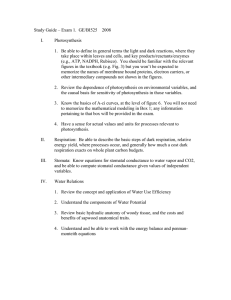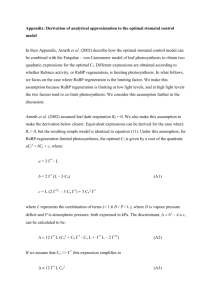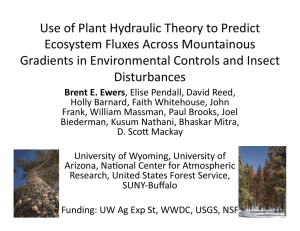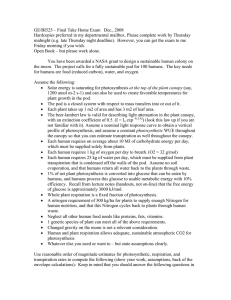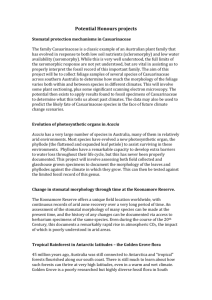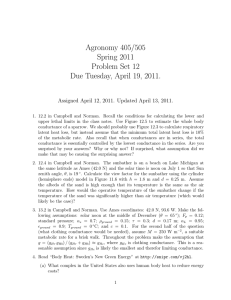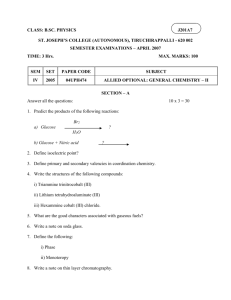Advance Journal of Food Science and Technology 8(2): 146-149, 2015
advertisement
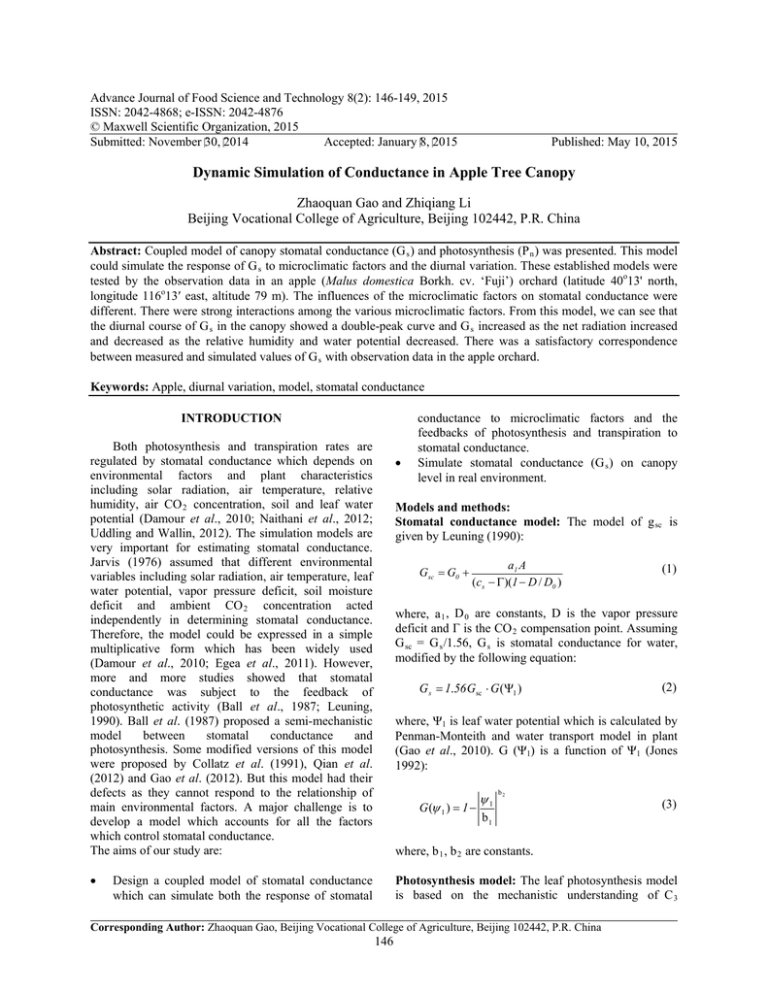
Advance Journal of Food Science and Technology 8(2): 146-149, 2015
ISSN: 2042-4868; e-ISSN: 2042-4876
© Maxwell Scientific Organization, 2015
Submitted: November 30, 2014
Accepted: January 8, 2015
Published: May 10, 2015
Dynamic Simulation of Conductance in Apple Tree Canopy
Zhaoquan Gao and Zhiqiang Li
Beijing Vocational College of Agriculture, Beijing 102442, P.R. China
Abstract: Coupled model of canopy stomatal conductance (G s ) and photosynthesis (P n ) was presented. This model
could simulate the response of G s to microclimatic factors and the diurnal variation. These established models were
tested by the observation data in an apple (Malus domestica Borkh. cv. ‘Fuji’) orchard (latitude 40o13' north,
longitude 116o13′ east, altitude 79 m). The influences of the microclimatic factors on stomatal conductance were
different. There were strong interactions among the various microclimatic factors. From this model, we can see that
the diurnal course of G s in the canopy showed a double-peak curve and G s increased as the net radiation increased
and decreased as the relative humidity and water potential decreased. There was a satisfactory correspondence
between measured and simulated values of G s with observation data in the apple orchard.
Keywords: Apple, diurnal variation, model, stomatal conductance
INTRODUCTION
Both photosynthesis and transpiration rates are
regulated by stomatal conductance which depends on
environmental factors and plant characteristics
including solar radiation, air temperature, relative
humidity, air CO 2 concentration, soil and leaf water
potential (Damour et al., 2010; Naithani et al., 2012;
Uddling and Wallin, 2012). The simulation models are
very important for estimating stomatal conductance.
Jarvis (1976) assumed that different environmental
variables including solar radiation, air temperature, leaf
water potential, vapor pressure deficit, soil moisture
deficit and ambient CO 2 concentration acted
independently in determining stomatal conductance.
Therefore, the model could be expressed in a simple
multiplicative form which has been widely used
(Damour et al., 2010; Egea et al., 2011). However,
more and more studies showed that stomatal
conductance was subject to the feedback of
photosynthetic activity (Ball et al., 1987; Leuning,
1990). Ball et al. (1987) proposed a semi-mechanistic
model
between
stomatal
conductance
and
photosynthesis. Some modified versions of this model
were proposed by Collatz et al. (1991), Qian et al.
(2012) and Gao et al. (2012). But this model had their
defects as they cannot respond to the relationship of
main environmental factors. A major challenge is to
develop a model which accounts for all the factors
which control stomatal conductance.
The aims of our study are:
•
•
conductance to microclimatic factors and the
feedbacks of photosynthesis and transpiration to
stomatal conductance.
Simulate stomatal conductance (G s ) on canopy
level in real environment.
Models and methods:
Stomatal conductance model: The model of g sc is
given by Leuning (1990):
Gsc = G0 +
a1 A
(cs − Γ)(1 − D / D0 )
(1)
where, a 1 , D 0 are constants, D is the vapor pressure
deficit and Γ is the CO 2 compensation point. Assuming
G sc = G s /1.56, G s is stomatal conductance for water,
modified by the following equation:
G s = 1.56 Gsc ⋅ G (Ψl )
(2)
where, Ψ l is leaf water potential which is calculated by
Penman-Monteith and water transport model in plant
(Gao et al., 2010). G (Ψ l ) is a function of Ψ l (Jones
1992):
G (ψ l ) = 1 −
ψl
b2
(3)
b1
where, b 1 , b 2 are constants.
Photosynthesis model: The leaf photosynthesis model
is based on the mechanistic understanding of C 3
Design a coupled model of stomatal conductance
which can simulate both the response of stomatal
Corresponding Author: Zhaoquan Gao, Beijing Vocational College of Agriculture, Beijing 102442, P.R. China
146
Adv. J. Food Sci. Technol., 8(2): 146-149, 2015
photosynthesis encapsulated in the description of
Farquhar et al. (1980) and modified by others (Leuning,
1990; Egea et al., 2011; Qian et al., 2012). The
equations describing net photosynthetic rate (A) were
given as follows:
A = min{Ac , Aq }− Rd
RESULTS
The simulation of canopy stomatal conductance: The
response of average G s of the apple tree canopy
(LAI = 3) to the microclimatic factors was presented in
Fig. 1. The results showed that G s were mostly affected
by Radiation (R a ) and air Temperature (T a ). G s
increased with the increase of R a . As T a increased, the
change of G s followed a bell-shaped curve (Fig. 1A and
B). The influence of net Radiation (R a ) on G s depended
on the net radiation flux density. When R a was below
200 W/m2, there existed a positive linear relationship
between G s and R a . G s did not show a significant
increase when R a increased from 200 to 800 W/m2
(Fig. 1B and C).
Generally there was a negative correlation between
CO 2 concentration and G s . The effect was stronger
when CO 2 concentration was below 350 μmol/mol.
However a positive correlation between CO 2 and G s
was found when CO 2 concentration was below 100
μmol/mol (Fig. 1A and C). This was because under low
CO 2 concentration the feedback of photosynthesis to
G s was stronger than the effect of CO 2 concentration
on G s . It should be noted that the temperature optimum
of G s shifted to a higher temperature as PAR, CO 2
increased or RH decreased (Fig. 1A, B and D). Strong
interactions existed in the various microclimatic factors,
especially between T a and R a , R a and CO 2 .
(4)
where, A c is the gross rate of photosynthesis limited by
Rubisco activity, A q is the gross rate of RuBP
regeneration through electron transport and R d is
Respiration which is strongly dependent on leaf
temperature. If I = I (i) the canopy photosynthesis (P n )
per unit ground area (m-2) is:
n
Pn = ∑ li A[ I ( i ) ]
(5)
i =1
where, l i is the leaf area (m2) of the ith layer (which
receives a light intensity I (i) on per unit ground area).
For the biochemical model, the driving variable c i
was calculated according to:
ci = ca − A / g sc
(6)
where,
c a = Air CO 2 concentration
= Stomatal conductance to CO 2
g sc
Diurnal variation of stomatal conductance: Diurnal
changes of G s of apple trees were simulated by the
models (Fig. 2). The microclimatic data used were from
June 14th to 19th in 2013 during which it was clear from
June 17th to 19th, cloudy from June 14th to 16th. The
diurnal course of G s was simulated according to Eq. (1)
and meteorological data. It showed a double-peak type
curve on clear days. G s were at its peaking at midmorning about 9:30 and mid-afternoon about 15:00.
The decline of G s at noon was caused by RH and Ψ l .
On the cloudy day of 14th to 16th, lower R a and T a
caused by less sunshine and more clouds led to a
decrease in G s by about 66%, compared to the values
on clear days. The change of T a depended on R a and
had about 2 h lag from R a . The variation of RH was
basically controlled by the variation of T a since e a
(absolute humidity) remained as a constant. So the
radiation intercepted by the canopy became the major
factor that affected stomatal conductance in plant. The
fluctuation of stomatal conductance was caused by the
fluctuation of radiation, too.
The correlations between measured and simulated
values of G s were shown in Fig. 3. For G s correlation
coefficients of the linear regression equations between
measured and simulated values was close to 1. The R
values for the regressions were also high. Hence, the
models and parameters used in this study were good
enough to predict G s with different microclimatic
MATERIALS AND METHODS
The experiment was carried out in a ‘Fuji’ apple
(Malus domestica Borkh. cv. ‘Fuji’) orchard from 2013
to 2014. The orchard is in the farm of ‘Zhongri’
Orchard (latitude 40o 13′ north, longitude 116o 13′ east,
altitude 79 m) in Changping county of Beijing. The
‘Fuji’ apple trees were planted in 1994 in south-north
rows at a density of 667 plants/ha. The planting spacing
was 5×3 m. Each tree was trained as an open-center
system. The soil of the orchard was loam soil and soil
water was always adequate.
Leaf stomatal conductance was measured by an
AP4 Porometer (AP4, Delta-T, UK). Leaf
photosynthetic rate was measured by the Li-6400
Portable Photosynthesis System (LI 6400; LI-COR,
USA). The canopy radiant interception was simulated
by Beer’s law (Johnson et al., 1989). The radiation in
different layer of apple tree canopy was measured by
LQF5 (Quantum Meter, USA). We presented 3D plots
to describe the effects of microclimatic factors and their
interaction. All the parameters were estimated with a
nonlinear optimization technique or from previous
reports (Leuning, 1990; Gao et al., 2010, 2012).
147
Adv. J. Food Sci. Technol., 8(2): 146-149, 2015
Fig. 1: The response of stomatal conductance (G s ) per unit ground in apple orchard to net radiation flux density (R a ), air relative
humidity (RH), air temperature (T a ) and air CO 2 concentration (CO 2 )
Fig. 2: The diurnal variation of stomatal conductance (G s ) and photosynthesis rate (P n ) per unit ground in apple orchard from
June 14th to 19th (LAI = 3)
factors in apple tree canopies. There was a slight
underestimation in G s , which might be caused by light
flares and faculae in the canopy.
DISCUSSION
Implementing the coupled models of apple canopy
has been successful in predicting the regulation of G s in
response to various microclimatic factors. The models
included the feedback of transpiration to stomatal
conductance through leaf water potential and the
feedback of photosynthesis to stomatal conductance
through Ball et al. (1987). These models can be applied
in the future for solving various theoretical and applied
tasks, e.g., the study of plant physiological dynamic,
water management in fruit orchards. In addition it can
Fig. 3: The relationship between measured and simulated
values of stomatal conductance in apple canopy
148
Adv. J. Food Sci. Technol., 8(2): 146-149, 2015
also be used to predict the responses of leaf
photosynthetic rates to elevated atmospheric CO 2
concentration and increased temperature, which is
fundamental to projecting the impact of global change
on the biosphere (Damour et al., 2010; Uddling and
Wallin, 2012).
The model of stomata is very important for
simulating water loss and photosynthetic rates of the
plant (Damour et al., 2010; Naithani et al., 2012; Qian
et al., 2012). But both the empirical and semimechanistic models cannot respond to environmental
variables and feedbacks of transpiration and
photosynthesis at the same time. Our coupled model
solved these problems. The feedback of transpiration to
stomatal movement was described with the steady state
water flow equation, stomatal model and P-M equation.
And through semi-mechanistic model of stomatal
conductance and biochemical model of photosynthesis
the feedback of P n to stomatal behavior was described.
Leaf water potential might have acted as a hydraulic
signal to partly closing stomata (Shahnazari et al.,
2007). Then the connection between T r and P n was
established through the stomatal model. There were
strong interactions between the various microclimatic
factors. Therefore, we should consider the interactions
when discussing the influences of environmental factors
on stomatal conductance. In our study the maximum G s
occurred at air CO 2 concentration of 100 μmol/mol
because of the feedback of P n . This result is similar to
other studies (Dubbe et al., 1978).
Dubbe, D.R., G.D. Farguhar and K. Raschke, 1978.
Effect of abscisic acid on the gain of the feedback
loop involving carbon dioxide and stomata. Plant
Physiol., 62: 413-417.
Egea, G., A. Verhoef and P.L. Vidale, 2011. Towards
an improved and more flexible representation of
water stress in coupled photosynthesis-stomatal
conductance models. Agr. Forest Meteorol., 151:
1370-1384.
Farquhar, G.D., S. von Caemmerer and J.A. Berry,
1980. A biochemical model of photosynthetic CO 2
assimilation in leaves of C 3 species. Planta, 149:
78-90.
Gao, Z., T. Li and X. Zhang, 2010. The dynamic
diurnal simulation of gas exchange in apple leaves.
Acta Ecol. Sinica, 30(5): 1258-1264 (In Chinese).
Gao, Z., C. Zhao, X. Zhang and S. Feng, 2012. The
simulation of three-dimensional canopy net
photosynthtic rate of apple tree. Acta Ecol. Sinica,
32(21): 6688-6694 (In Chinese).
Jarvis, P.G., 1976. The interpretation of the variations
in leaf water potential and stomatal conductance
found in canopies in the field. Philos. T. Roy. Soc.
B, 273: 593-610.
Johnson, I.R., A.J. Parsons and M.M. Ludlow, 1989.
Modelling photosynthesis in monocultures and
mixtures. Aust. J. Plant Physiol., 16(6): 501-516.
Jones, H.G., 1992. Plants and Microclimat: A
Quantitative Approach to Environmental Plant
Physiology. 2nd Edn., Cambridge University
Press, Cambridge, pp: 145-161.
Leuning, R., 1990. Modeling stomatal behavior and
photosynthesis of Eucalyptus grandis. Aust.
J. Plant Physiol., 17: 159-175.
Naithani, K.J., B.E. Ewers and E. Pendall, 2012.
NASap flux-scaled transpiration and stomatal
conductance response to soil and atmospheric
drought in a semi-arid sagebrush ecosystem.
J. Hydrol., 464-465 (25): 176-185.
Qian, T., A. Eling, J.A. Dieleman, G. Gort and
L.F.M.
Marcelis,
2012.
Estimation
of
photosynthesis parameters for a modified
Farquhar-von Caemmerer-Berry model using
simultaneous estimation method and nonlinear
mixed effects model. Environ. Exp. Bot., 82:
66-73.
Shahnazari, A., F. Liu, M.N. Andersen, S.E. Jacobsen
and C.R. Jensen, 2007. Effects of partial root-zone
drying on yield, tuber size and water use efficiency
in potato under field conditions. Field Crop. Res.,
100: 117-124.
Uddling, J. and G. Wallin, 2012. Interacting effects of
elevated CO2 and weather variability on
photosynthesis of mature boreal Norway spruce
agree with biochemical model predictions. Tree
Physiol., 32: 1509-1521.
ACKNOWLEDGMENT
This research was supported by Program for
Beijing Municipal Commission of Rural Affairs
(20140137, 20140204-6).
REFERENCES
Ball, J.T., I.E. Woodrow and J.A. Berry, 1987. A
Model Predicting Stomatal Conductance and its
Contribution to the Control of Photosynthesis
under Different Environmental Conditions. In:
Biggens, I. (Ed.), Progress in Photosynthesis
Research. Martinus
Nijhoff
Publishers,
Netherlands, pp: 221-224.
Collatz, G.J., J.T. Ball, C. Griver and J.A. Berry, 1991.
Physiological and environmental regulation of
stomatal
conductance,
photosynthesis
and
transpiration: A model that includes a laminar
boundary layer. Agr. Forest Meteorol., 54:
107-136.
Damour, G., T. Simonneau, H. Cochard and L. Urban,
2010. An overview of models of stomatal
conductance at the leaf level. Plant Cell Environ.,
33(9): 1419-1438.
149
